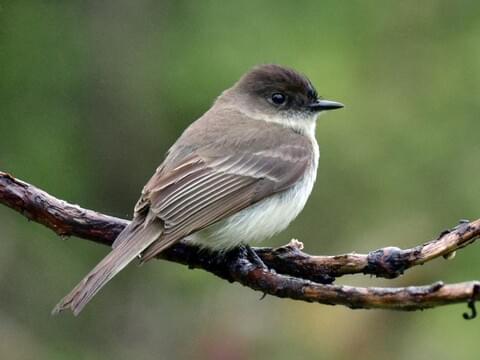When Is It Time to Leave the Nest?
I was sure they were dead. The dark little bodies were crowded into the high corner of the breezeway where generations of our resident phoebes have kept a nest for years.
Nothing stirred there, not the tiny charcoal grey heads, not the delicate gold beaks.
They nestled in a dark, torrid May heat — 90 degrees and more — motionless. Had the heat taken their brief, fragile lives away?
To add to our worry, there was no sign of the mother, who typically swings back and forth between the nest and nearby foliage with the seeds and insects her small brood require.
My husband and I watched fearfully, and for a long time.
When I couldn’t stand it any longer, I took the field glasses to get a closer look. To my shock, there were 5 bodies in a space normally occupied by 3. And these bird bodies were large — terribly large and developed to still be seeking the shelter of the nest. It was suffocating to see, frightening, almost obscene.
In the natural sequence of things, these birds would have flown out into the world already. Yet, they hung back, inexplicably.
Why? What was wrong with this picture?
And how on earth, I wondered, could the mother continue to provide food and water to such overgrown children?
As evening came on, but no less terribly, I saw that they weren’t dead at all. Five hungry mouths had flung wide open, as if they were wailing, for food. They craned and pressed against the confines of the nest, needy, helpless, demanding.
A painful scene. And there seemed nothing I could do. Cardinals, finches, blue birds swung and swerved around them, meeting in a bit of combat at the feeder or atop the houses scattered in the meadow. These seemed stuck, inert, paralyzed.
. *****************************************************
We all tend to hang on when it’s time to fly. All of us have witnessed the delayed “launch” of a child, a friend — and ourselves. We know only too well the fine line between nudging someone we love to take the next step, and perceiving a hidden weakness in need of care. Invariably, we respond by trying to protect, to help strengthen, to heal.
Always, always, that fine line. If we push too soon or too hard, disaster follows. If we hover and protect — others, ourselves — we eventually abort the trajectories of freedom and growth.
This is where we find ourselves at this moment in time. During COVID, we discovered the grace notes hidden in our retreat to the security of our nests. Sometimes they were cramped and dark, it is true. But they were safe. And this safety allowed us to reconsider our priorities, our choices, the quality of our lives.
- Did we want to be so overextended? So involved in so many commitments?
- Did we want to spend more time and energy on our closest relationships than we had in a while?
- What might be a better balance? What did we want to let go of?
- What, in us, longed to fly in a new kind of freedom?
Like the baby phoebes, we are physically ready to fly, but something is holding us back.
How to proceed?
The first thing to be aware of is the resurfacing of all the false lures. We can now resume our existence as busy consumers. We can buy more restaurant meals, travel, take in live culture.
We can re-engage the old ambitions and routines: health clubs, long work weeks, volunteer meetings.
The important question is this:
How — absent a mother bird who either withholds food, or shoves us out — do we ready ourselves to leave the smaller spaces of our lives for something genuinely larger? Something soul-enlarging? Mind-and spirit enhancing?
I want to suggest three practices.
First, don’t try to embrace “all of it” all at once. This kind of “big thinking” only overwhelms us. Instead, try simple curiosity. Ask what speaks to you, in these days of more communication, more exposure, more of everything. What calls you? What draws a deep spark of assent from you?
Do not judge what you discover, but do record and keep track of it in a journal. Allow your innermost being, your intuition, to speak to you. Take the time to listen.
Second, spend time each day meditating on this question:
What wants to come to life in you NOW? What do you long to welcome in — or continue to welcome, from the time of retreat? Imagine what this might look like, in real terms, in your life going forward.
Third, commit yourself to performing at least one small act of kindness each day. The very practice of thinking of others, generating creative ideas for a generous gesture — a visit, a phone call, a cut flower from the garden — will take you out of yourself and vastly expand your view of what is possible.
That’s it. Next week, I will continue this discussion.
Please let me know how your practices proceed…!! Send in a comment here.
And now dear friends…adieu with an update. Just as I was preparing to post this, the phoebes flew!!! All 5 of them!!!
You, too, can do it.
Best wishes and namaste.
(photo credit: Allaboutbirds.org)





Elizabeth Rhymer
June 13, 2021at9:06 amI like your action steps, your “three practices.” I was thinking of going to Portland for something I don’t really need right now and stopped to consider what it is that is calling me. It’s my garden. I’ll go out and do some weeding, a contemplative practice and grounding, restful, peaceful, and useful. I loved the phoebe story and appreciate the update! I would have been worried about those five big babies.
Kathleen Hirsch
June 13, 2021at10:27 amI so appreciate your “second thought” and decision to garden. Yes!!! I thoroughly enjoyed yesterday at the library! You are such an inspiration.